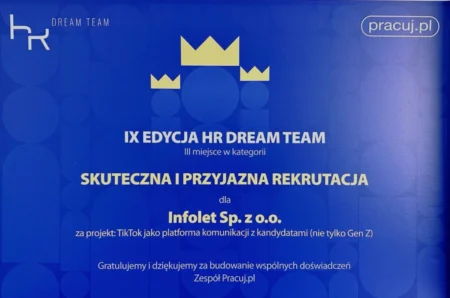Reducing recruitment costs
- what are the ways?20.08.2024
Recruitment costs are a significant item in a developing company’s budget. According to Business Insider*, recruiting one employee costs around PLN 5,000. In the case of unsuccessful recruitment, the cost increases threefold to PLN 15,000 per employee. If you think the best way to reduce recruitment costs is to reduce employment in the HR department, this article will show other ways.
- What are the ways to reduce recruitment costs?
- Are there universal solutions for every organisation?
- Do cost cuts in the recruitment process negatively affect candidate experience?
- What solutions do we use at Infolet to optimise recruitment costs?
You will find the answers to these and other questions below.
What are the quick ways to reduce employee recruitment costs?
The effectiveness of methods for reducing recruitment costs depends on how quickly the effect of cost reduction is to be visible.
If you need to reduce recruitment costs immediately, the following actions may bring the effect immediately after their implementation.
The most popular of them are:
- to publish a job offer on the company website,
- to use free job portals or particular groups in social media,
- to conduct internal recruitment,
- to ask employees to recommend friends who might be interested in the position.
These actions will work if:
- We want to employ a small number of people (1-2 people for a specific recruitment),
- We have a recognisable brand,
- Employees are happy with their work in the company and are willing to recommend working there,
- There is no time pressure – recruitment is not urgent.
If we are a large, recognisable company and employees are proud to work there, recruiting some more employees faster should not be a problem.
If our business does not meet the above factors, cutting the budget for advertisements on a paid portal may result in not receiving the expected number of applications. Consequently, the time to acquire an employee will be significantly longer. As a result, the company’s cost of not hiring an employee on time will be higher than the savings made.
What actions will effectively reduce recruitment costs?
If recruitment costs take up a significant part of the company’s budget, it is worth treating their reduction as an element of its strategy.
It would help if you prepared your managers for the fact that this is a long-term process, the effects of which will only become visible after some time.
Actions that can reduce the costs of the recruitment process:
- Automation of the recruitment process. Recruitment process management software will automate the collection and processing of applications or the scheduling of interviews. A well-chosen tool will streamline and speed up the HR department’s work.
- Internal training and employee development. Investing in the development of already employed employees increases their skills and chances for internal promotion. Thanks to this, employees can be more loyal and willing to recommend friends for new positions. Additionally, such an employee will implement new duties much faster and know the company, products, and culture. Internal recruitment can be more cost-effective and qualitative, in the long term, than recruiting a specialist from outside.
- Alternative methods to traditional job interviews. Instead of multi-stage recruitment based on conventional job interviews, your in-house recruiters can use alternative recruitment methods. Practical tests, simulations of work-related tasks, or even gamification can give candidates a better experience and increase their engagement. Non-standard recruitment methods can help assess candidates’ actual skills. Doing so increases the likelihood of making more accurate recruitment decisions.
- Building an employer brand. Companies with a strong employer brand complete recruitment processes faster, hiring more engaged employees. Building a recognisable employer brand can be helped by an authentic and updated “Career” tab on the company website, attending conferences, job fairs or meetups, or maintaining social media profiles.
- Building a candidate database. Invest time and resources in building a candidate database. You can use Candidate Relationship Management (CRM) tools to track and maintain contact with potential candidates in the future. This allows you to avoid the costs of searching for new candidates every time a vacancy appears.
These activities reduce recruitment costs in the long term. However, the benefits of their implementation are more than just financial. If done well, these solutions will positively impact the candidate’s experience.
What solutions do we use at Infolet?
At Infolet, we use solutions that reduce the costs of recruiting an employee. We see how much of an impact an expanded and constantly updated candidate database has on the structure and effectiveness of the recruitment budget. We have been conducting activities to build the employer’s brand among our target group for many years. We have also implemented a recommendation program in which our employees can participate. However, the selection of appropriate tools to manage this process particularly influenced the optimisation of the recruitment process.
What tools allow for the optimisation of the company's costs?
In our case, the choice of tools was not a coincidence. We wanted not only to streamline and automate the recruitment process. Solutions for managing the candidate database were fundamental to us.
What does candidate database management mean to Infolet?
Firstly, we care about current information concerning candidates: their experience and professional goals.
The second issue is the storage and management of data by GDPR.
If you are wondering whether a recruitment system (ATS) is necessary in your company, these questions will help you make a decision:
- How often does recruitment need to arise in my company?
- Are the positions we recruit repetitive?
- How many applications are there for the published job positions?
- What does the recruitment process look like? Do I contact candidates at every stage?
- Is there a person who will take care of the system administration?
- Are candidates’ data processed along with GDPR?
- Is there a need to improve the efficiency of the HR department?
- Are there any planned activities to enhance the candidates’ experience of the recruitment process?
Candidate database as a tool for reducing employment costs
A regularly updated candidate database is an essential resource for the company. By re-contacting previously acquired candidates, we reduce recruitment costs. This is wildly profitable when we constantly conduct the same or similar recruitment. The possibility of contacting a candidate who has already applied to us can shorten the time of the entire process.
The advantage is that such contact positively impacts the candidate’s experience. We checked this at Infolet.
Candidates who have already applied and with whom our recruiters contact regularly later are more willing to engage in subsequent recruitment processes.
Recruiters with up-to-date information about the candidate in the system can present a more tailored offer. What’s more, they can contact candidates while they are finishing the project.
A good ATS allows you to set such reminders, which relieves the recruiter of the need to remember a lot of information. A recruitment management system replaces a notebook or calendar.
Candidate database as a competitive advantage
Can using an ATS positively impact a company’s competitive advantage? Yes, in many dimensions.
A very measurable aspect is the reduction of the costs of acquiring an employee. There is no need to spend money on advertisements on job portals or extensive recruitment campaigns.
Another advantage is the shorter time it takes to reach the suitable candidates with the offer. We contact candidates who have previously applied to us.
A less measurable dimension is the positive impact of maintaining contact with candidates who have applied in the past on the company’s image and the candidate’s experience.
Some time ago, on our company profiles and social media, we asked, “Did the recruiter contact you again after finishing the recruitment process?”
The results were almost the same on each platform. Over 70% of respondents (on LinkedIn, TikTok, and Instagram) answered that the recruiter did not contact them again. Although we expected such answers, the percentage distribution completely surprised us.
Why don’t companies use the potential that they have almost for free? After all, they have already paid for these applications by publishing a job offer on the portal.
Even if a given candidate did not meet the requirements of the previous job offer, they may already meet them after a few months or a year.
Database management and recruitment costs - summary
By effectively using the candidate database:
- You have a resource of potential candidates.
- You act by the law, collecting data in a justified manner.
- You maintain relationships with candidates, which positively impacts the company’s image.
- You reduce recruitment costs and shorten the recruitment time.
At Infolet, after implementing a candidate database management strategy, we achieved better results in recruitment processes. We reduced costs and employment time, and the Human Resources Department works more efficiently.





